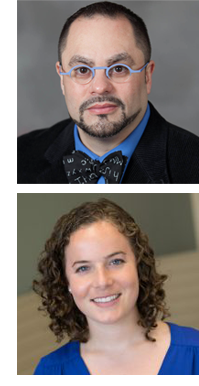| |
 MIT BLOSSOMS is heading in a new direction: to provide high school STEM teachers with the guidance and resources they will need to feel confident leading a 3 to 4-week Project-Based Learning (PBL) lesson for their students. BLOSSOMS is pursuing this initiative because so many teachers have said they want to do longer-term projects with their students, but don’t feel sufficiently trained in PBL. MIT BLOSSOMS is heading in a new direction: to provide high school STEM teachers with the guidance and resources they will need to feel confident leading a 3 to 4-week Project-Based Learning (PBL) lesson for their students. BLOSSOMS is pursuing this initiative because so many teachers have said they want to do longer-term projects with their students, but don’t feel sufficiently trained in PBL.
PBL has been shown to be a superior way for students to become engaged in STEM and to develop deep critical thinking skills by applying STEM concepts to complex real problems. Students collect data, create and test hypotheses, speak with stakeholders, frame and formulate an approach to the problem, make mid-course corrections, and eventually present their final results and recommendations in both written and oral form.
In this new initiative, five BLOSSOMS video lessons will serve as anchors for a teacher’s first implementation of PBL in the classroom. For each lesson, BLOSSOMS will provide a detailed and comprehensive follow-on Project-Based Learning lesson plan that equips teachers to run an extended project with their classes. Our ultimate goal is to have the teachers feel comfortable and competent to design and implement their own PBL lessons.
The following topics will be covered in these five new PBL lesson plans, each of which will kick off from a 50-minute BLOSSOMS video lesson:
- Applying the principles of Green Chemistry to real world problems;
- Examining the properties of water and their relevance to our own lives;
- Tragedy of the Commons: a metaphor for overuse and abuse of shared public resources;
- Understanding the dynamics of Complex Systems as applied to recycling;
- Design thinking & User-centered Design for solving global challenges.
| |
Meet Two BLOSSOMS PBL Teachers |
|
| |
|
|
| |
 Ann Lambert and Cara Diiorio have developed the first BLOSSOMS follow-on Project-Based Learning lesson, which is on the topic of Green Chemistry. Both are teachers at the King Philip Regional High School in Wrentham, MA where Ann is head of the science department. Ann has taught science for 23 years and is also a lead teacher at Beyond Benign, Inc., a non-profit working to revolutionize the way chemistry is taught globally by advocating that green chemistry becomes an integral part of chemical education. Cara has taught for 5 years and finds that infusing principles of Green Chemistry and toxicology into her curriculum makes her students better citizen scientists. In 2016, Ann created the BLOSSOMS video lesson, “Green Chemistry: The Science of Solutions,” which will serve as the anchor for their follow-on PBL lesson. That PBL lesson guides students through a learning process that culminates in their own self-selected lifecycle analysis project. The lesson also provides an optional extension in which students apply engineering principles to develop and test a sustainable, polystyrene substitute product. Ann Lambert and Cara Diiorio have developed the first BLOSSOMS follow-on Project-Based Learning lesson, which is on the topic of Green Chemistry. Both are teachers at the King Philip Regional High School in Wrentham, MA where Ann is head of the science department. Ann has taught science for 23 years and is also a lead teacher at Beyond Benign, Inc., a non-profit working to revolutionize the way chemistry is taught globally by advocating that green chemistry becomes an integral part of chemical education. Cara has taught for 5 years and finds that infusing principles of Green Chemistry and toxicology into her curriculum makes her students better citizen scientists. In 2016, Ann created the BLOSSOMS video lesson, “Green Chemistry: The Science of Solutions,” which will serve as the anchor for their follow-on PBL lesson. That PBL lesson guides students through a learning process that culminates in their own self-selected lifecycle analysis project. The lesson also provides an optional extension in which students apply engineering principles to develop and test a sustainable, polystyrene substitute product. |
|
| |
|
|
|
|
These five video lessons – including those in the domains of Physics, Chemistry, Biology, Earth Science and Engineering - are part of a new initiative aimed at providing clear and scaleable instruction for high school teachers around NGSS. In those 19 states plus the District of Columbia that have adopted these standards, teachers have found it difficult to understand all that is expected of them in this new way of teaching science. For example, lessons and units should be anchored by a phenomenon as a driving mechanism for student questions and sense-making. Furthermore, in addition to straight domain content, NGSS requires the inclusion of crosscutting concepts and science and engineering practices. Finally, teachers have found it difficult to develop assessments that adequately cover the objectives of this transformed style of science learning.
These five new BLOSSOMS video lessons are different than traditional BLOSSOMS lessons in that they are designed to explicitly demonstrate the three major requirements of NGSS mentioned above. Each will serve as the anchor of an online, downloadable “Teacher Professional Learning package” for that specific academic domain. Along with the anchor video lesson, each domain TPL package will also include an edited video of that lesson being taught by a master teacher to students in a live classroom. Each domain package will also include video clips of conversations with the master teacher who taught the lesson, and also with students who were in the teacher’s live class.
The goal of this initiative is to have the five TPL packages described above integrated into comprehensive Teacher Professional Learning workshops facilitated locally by experienced NGSS leaders. The “packages” will serve as the core of five different workshops, training teachers in each of the five NGSS disciplinary domains.
| |
Meet Two BLOSSOMS TPL Teachers |
|
| |
|
|
| |
 David Upegui and Emily Berman have each created a video lesson for BLOSSOMS’ new Teacher Professional Learning initiative. David has taught science for 9 years at his own alma mater, the Central Falls High School in Central Falls, RI. There he works to ensure that new generations of students have opportunities to develop the sense of agency that freed him from economic -and intellectual - poverty. In 2015 he was selected as a state finalist for the Presidential Awards for Excellence in Mathematics and Science Teaching and was also the 2014 Recipient of the National Association of Biology Teacher’s Evolution Education Award. His TPL video lesson looks at the critical role of biological diversity. Emily is a teacher at the Blackstone Academy Charter School in Pawtucket, Rhode Island where she has taught high school biology, chemistry, and engineering for the past 4 years. She is a 2015 recipient of the Knowles Science Teaching Fellowship (KSTF), a five-year fellowship dedicated to supporting STEM teachers. She is also a 2017 TeachPlus Rhode Island Fellow - a fellowship that empowers excellent teachers to take leadership roles. Her TPL video lesson engages students in the engineering practices while focusing on the foundational chemistry topic of reaction rate. David Upegui and Emily Berman have each created a video lesson for BLOSSOMS’ new Teacher Professional Learning initiative. David has taught science for 9 years at his own alma mater, the Central Falls High School in Central Falls, RI. There he works to ensure that new generations of students have opportunities to develop the sense of agency that freed him from economic -and intellectual - poverty. In 2015 he was selected as a state finalist for the Presidential Awards for Excellence in Mathematics and Science Teaching and was also the 2014 Recipient of the National Association of Biology Teacher’s Evolution Education Award. His TPL video lesson looks at the critical role of biological diversity. Emily is a teacher at the Blackstone Academy Charter School in Pawtucket, Rhode Island where she has taught high school biology, chemistry, and engineering for the past 4 years. She is a 2015 recipient of the Knowles Science Teaching Fellowship (KSTF), a five-year fellowship dedicated to supporting STEM teachers. She is also a 2017 TeachPlus Rhode Island Fellow - a fellowship that empowers excellent teachers to take leadership roles. Her TPL video lesson engages students in the engineering practices while focusing on the foundational chemistry topic of reaction rate. |
|
| |
|
|
|
|